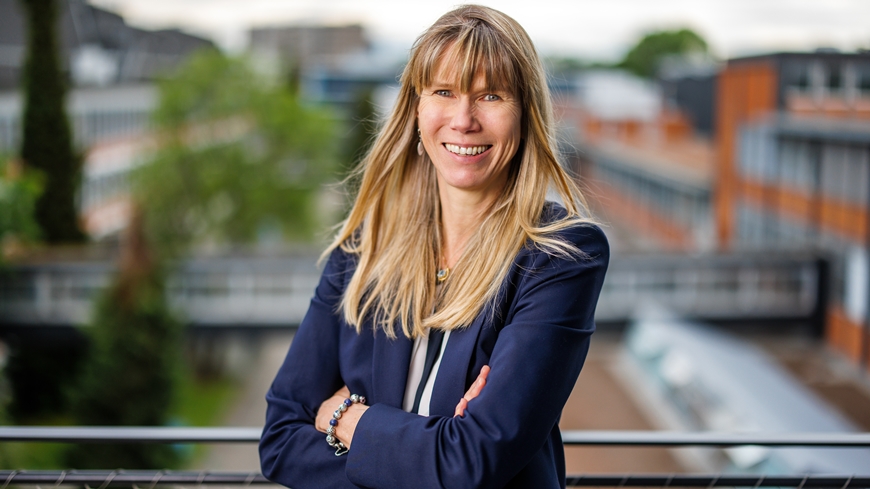Interview
“We are doing something here that is relevant to everyone”
A successful implementation of Switzerland’s Energy Strategy 2050, personalized diagnostics and therapies for an aging society and a competence center for quantum technologies – Tanja Zimmermann has set herself ambitious goals. In an interview, the new director explains why her heart beats for Empa.

You took over as director of Empa on 1 June. What are your thoughts and feelings with regard to your new task?
I’m looking forward to an extremely exciting task, and I’m highly motivated to tackle it – because I really have put a lot of heart and soul into Empa. You can see that in my resume. I was already splitting wood here as an intern and then climbed the career ladder. So I know how a group leader feels, where a lab head’s shoe pinches, and what challenges a department head is facing. And I know that there are many highly motivated teams working at Empa. But of course I also have a lot of respect; I am succeeding Gian-Luca Bona, who has positioned Empa extremely successfully over the last 13 years. Empa is in a better position today than it has ever been since I’ve known it – and I’ve known it for a quite a while.
Why is there so much “heart and soul”? What’s so cool about Empa?
We are doing something meaningful here, something useful, something that is relevant to the lives of all of us. When you realize at the end of a successful research project: Ah, something has really come out of this, something that has helped company X in a very specific, down-to-Earth way – that is the pure opposite of the ivory tower. It is really very satisfying.
Where do you currently see the biggest challenges that you want to tackle with Empa?
First of all, there is the implementation of the Swiss Energy Strategy 2050, which we will have to achieve as fast as possible, i.e. the development of CO2-neutral technologies. Empa should play a pioneering role in decarbonization, that’s one of the goals I’ve set myself. Another core topic – the keyword is aging society – is personalized medicine, i.e. the development of more specific diagnostic and therapeutic methods that are tailored to individual patients. How can we prevent or delay the need for hospitalization? Environmental influences such as noise or air pollutants play a significant role in many diseases, especially in densely populated countries like Switzerland.

What can Empa contribute to solving these problems?
By continuing to position Empa as the first address for Swiss industry as “The Place where Innovation Starts”. It is important to close the gap between what already works in the lab and its industrial implementation because many brilliant ideas often disappear in this “valley of death”. To build bridges here, we have launched a number of technology transfer platforms such as NEST, move and our Coating Competence Center. We need to expand these further, but we also need to go a step further in the value chain, such as the technology transfer centers in the field of Advanced Manufacturing. And then there are the innovation parks.
Good keyword: Both in St. Gallen and in Dübendorf, the innovation parks are located virtually on Empa’s doorstep. What do you expect from this proximity?
For us, the innovation parks are natural partners in Switzerland’s innovation ecosystem. I envision them as a kind of meeting point, a market place for ideas where all stakeholders from politics, industry, research and society can exchange ideas about innovation. Dialog with society will play a central role in the future, because technologies are influencing ever larger areas of our daily lives. Just think of the rapidly advancing digitalization, artificial intelligence and robotics, but also the energy transition. We have to involve the public at an early stage and take them along with us, otherwise we will fail as a society.
Collaborations and partnerships are indispensable for interdisciplinary research. Which partnerships would you like to expand in the future?
No research institution – no matter how good it is – will be capable of solving the enormous challenges we face on its own; probably not even a country can do this alone. That’s why we need to work more closely together, both within the ETH Domain but also with Swiss universities and universities of applied sciences and make better use of synergies. And since I already mentioned international networking: It would be enormously – really: enormously – important for Switzerland to be fully associated with the EU’s research programs. It is absolutely imperative that we once again become an equal member of the European research family – also in order to be able to help shape the agenda for the coming years. A longer-term exclusion would have dire consequences for Switzerland’s international positioning.
Are there any research priorities that you would like to expand?
We have been working successfully on novel carbon nanostructures such as graphene for several years now and have recently received a grant of 15 million Swiss francs from the Werner Siemens Foundation, as well as an ERC grant and various SNSF grants in the field of quantum technologies. We would like to bundle these activities, for instance in a kind of competence center. Moreover, our activities in the field of data science have been expanding for some time.
You are the first woman to head Empa in 140 years. What does that mean for the institution?
On the one hand, it is encouraging that women can get into these positions. It serves as a role model for younger female researchers. I’ve been asked several times by younger female colleagues how I’ve managed to combine everything – career, family, children. My example shows that women can pursue a career in a research environment and have a family at the same time. But we also have to create suitable conditions for this or improve them further. I would definitely like to get more women into senior management positions, we can still do better in this respect.
Times are anything but calm: the aftermath of the pandemic, the non-association with EU research programs, presumably increasing expenditures for national defense. Not exactly rosy prospects for investment in research, are they?
I am convinced that research and innovation will remain of crucial importance for Switzerland. And fortunately, we do have a solid base funding. However, I don’t really expect our funding to increase significantly in the years ahead. So we would do well to explore alternative options.
Such as?
We have been operating very successfully with our “Zukunftsfonds” for some time now. This is going better and better, but there is definitely still room for improvement. At the moment, we are seeing donations and grants mainly in the area of medtech and personalized medicine. In future, we want to extend this to our other research areas, such as energy and the environment, but also to support young talents.
What are your personal goals for the next few years?
First of all, I would like to revive and give more momentum to the culture of collaboration at Empa – after two years of pandemic, there are certain signs of wear and tear. For me, being close to our employees is very important, as is personal exchange and mutual inspiration. If we can once again live these values better, motivation and good results will come all by themselves.
Which values are important to you?
Trust and an open, clear communication. And a certain culture of failure, which allows people to make mistakes because that’s how we learn – after all, that’s what research thrives on. What’s more, I would like to promote our young talents better and open up career opportunities for female researchers. In general, diversity is enormously important – I myself have had the best experiences in mixed teams.
-
Share

| Following the sun |
|
An Empa study now calculates the influence of energy storage systems on the maximum possible transition speed – and thus also on the probability of successfully mastering the climate crisis. |
|
Copper exposure in the environment and the protein alpha-synuclein in the brain could play an important role in the pathogenesis of Parkinson's disease. New findings could help develop strategies for the treatment of neurodegenerative diseases. |








